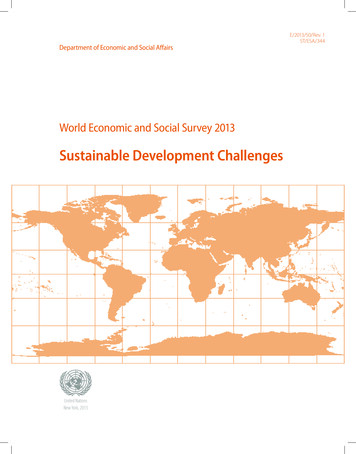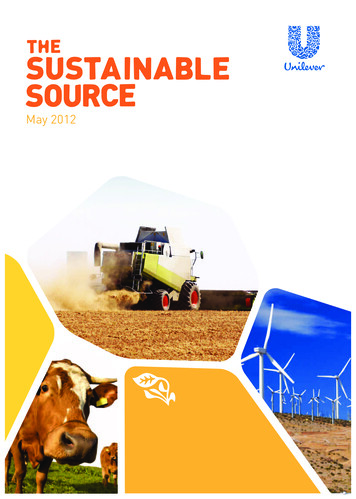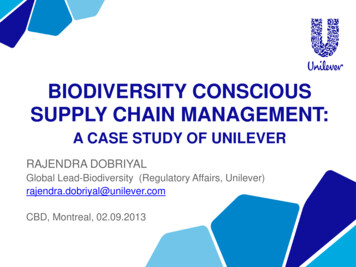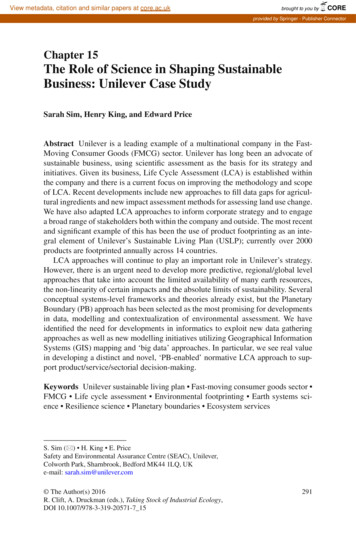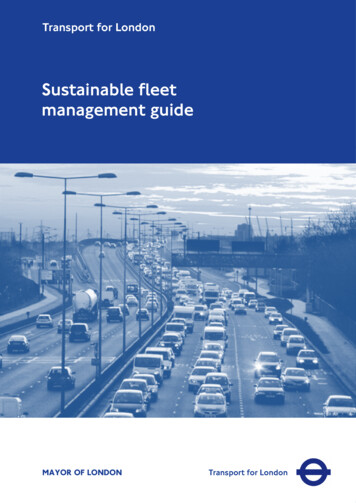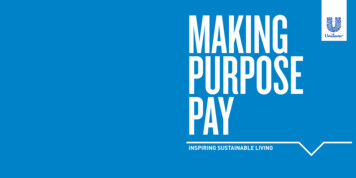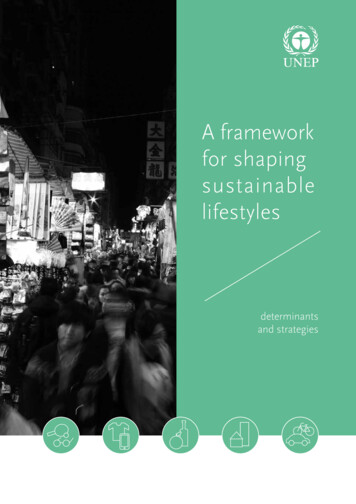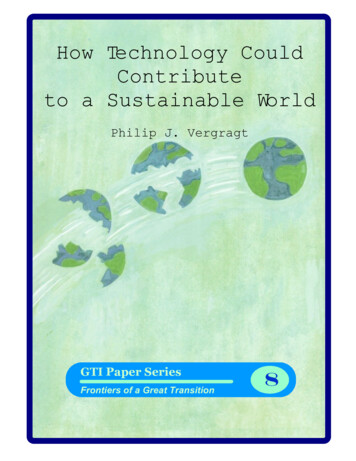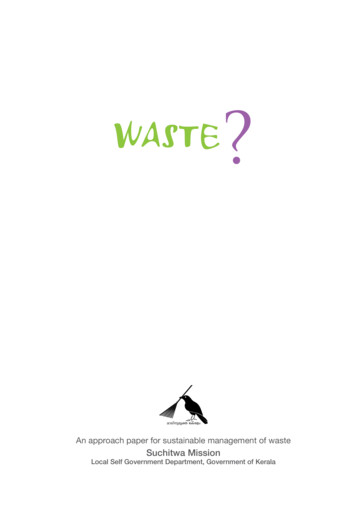
Transcription
An approach paper for sustainable management of wasteSuchitwa MissionLocal Self Government Department, Government of Kerala
(English)Waste ?ByDr. K. Vasuki IASFirst Edition: August 2015DesignGodfrey’s GraphicsIllustrationsJishnu P RajPublished bySuchitwa MissionLSGD, Government of KeralaSwaraj Bhavan, Basement Floor (-1)Nanthencode, Thiruvananthapuram - 03Ph:0471- 2312730, 2316730, Fax 2312730Email: suchitwamission@gmail.comNot for sale
CONTENTMessageForewordAcknowledgementsChapter 1Why To Manage Waste ?11Chapter 2Empty Your Glass13Chapter 3Zero Waste25Chapter 4The 1st R-Reduce29Chapter 5The 2nd R-Reuse39Chapter 6The 3rd R-Recycle45Chapter 7Coupling Home Composting WithGardening / Organic Farming59Chapter 8Recycling Non Biodegradable Waste65Chapter 9Operational Model87Chapter 10Summary And Action Points93Chapter 11Standard OperatingProcedure For Campaign97Conclusionary Remarks101Chapter 12
ThiruvananthapuramDate 10.08.2015Dr. M. K. MuneerMinister For Panchayats &Social Justice, KeralaThe Suchitwa Mission has been taking enormousefforts and variety of initiatives to achieve its vision“Waste Free Kerala with unpolluted environment”.The state is really in need of a clear-cut comprehensivestrategy and approach in Waste Management.Fulfillment of its vision requires public awarenessand public support.I hope this book will definitely give insight to allstakeholders and bring momentum toState’s endeavours towards its goal and will bea very useful guide for the Local SelfGovernment Institutions in Kerala.Let us together strive for the realizationof our dream of a ‘Clean Kerala’!Good wishes!SincerelyDr. M. K. MuneerPhone-Office : 0471-2327796, 0471-2327895 Res : 0471-2318601,2317651, Fax : 0471-2330102 Mobile: 9496355500, 9947041000e-mail: mkmuneer2@gmail.com, minister-panchayat@kerala.gov. in,minister.socialjustice@gmail.com
ThiruvananthapuramDate 21.10.2015Sri. A.P.M. Mohammed Hanish IASSecretary (Urban)Local Self Government DepartmentGovernment of KeralaKerala has been carrying outmultiple initiatives to address thechallenging issue of managing waste.I am happy to note that Suchitwa Missionhas come up with a strategy and approachto manage the issue environmentand people friendly.”The book ‘Waste?’will really give an insight to all theconcerned stakeholders, particularlythe LSGIs, to develop a strategy forthem in this sector.I wish them the best in their endeavours.SincerelyA.P.M. Mohammed Hanish IAS
FOREWORDBooks or monographs on waste treatmentare not exactly rare. People are alwayscoming up with cynical observations anderudite suggestions about waste treatment, oneof the most trying problems of modern era.Public minded citizens and erstwhile bureaucrats abound amongthem. However, a book written by a senior bureaucrat, heading agovernment sponsored Shuchitva Mission is something new. Butwhat is most refreshing about this book is that it appears not at alllike one prepared by a bureaucrat. At times it more or less echoes thevoices of civil activists, but in general it does reflect the practicalityand reasonableness of official missions. The welcome aspect is that itdoes not reflect the oft seen fad for high tech magic solutions whichhigh officials usually prefer and advocate as a panacea. The bookreveals a keen understanding of the ground reality as well as the stateof the art of technological solutions. Above all, it is spiced with awelcome sense of humour, so rare in official publications.The book appreciates the special situation in Kerala, the peculiarcomposition of its urban wastes and recognizes that composting isthe most appropriate procedure for treating it. It also recognizes thepractical problems with composting, in so densely populated a state,and the set backs from ill managed early attempts. Naturally, it doesnot recommend a one-track solution, but suggests a set of remedies,starting with the proverbial "Three Rs". Not surprisingly, it emphasizesthe role of the public, while not neglecting the role of the LSG bodiesin tackling this grave problem. Most unexpectedly, it also points tothe philosophical aspect of waste creation, which is becoming aninevitable part of modern civilization. So, in addition to the "ThreeRs", it also adds a fourth: "Refuse" - to limit our consumption, anaspect not normally dealt with in western publications.The fact that Shuchithva Mission, the official Agency to keep Keralaclean, is coming up with such an insightful manual, promises thatthe State Departments and Agencies will extend an enlightenedguidance in creating a "Clean Kerala."R V G Menon
FOREWORDWaste to wealth and not to waste. How will Indiancities manage the growing volumes of solid waste? Itis clear that with each coming year, while the quantum ofwaste that is being generated is increasing, our capacity tocollect, transport, dispose and reuse garbage is going down.As a result, cities are drowning in piles of refuse. This, inturn, is adding to public health challenges. It is for this reasonthe country needs to find approaches and models of wastemanagement that are affordable and sustainable.Kerala has done important work in this direction. It has taken leadership to setup the dedicated state level mission for total sanitation and a clean environment.The Suchitwa Mission was set up in 2008 and plays a critical role in determiningthe way the state should proceed to manage its waste. It is clear that the work inKerala will have important lessons for the rest of India. Kerala, because of its highpopulation density, high rates of literacy and growing environmental awareness hasthe right conditions for change. In the current situation, people are saying – rightly– that they do not have the waste of someone else in their backyard. This notin-my-backyard (NIMBY) syndrome is creating challenges for waste management.But what is important and interesting is that the state is open to look for new,innovative and path-breaking changes in the way waste is managed in our country.The work in Kerala to look for alternative models of waste management, whichrequire people to segregate waste at the household level and as far as possiblemanage it locally, are models for the entire country. They teach us that unless wecan learn the art and science of segregation of waste – at source – waste managementstrategies will be expensive and indeed futile. This is also the lesson from otherparts of the country, where waste-to-energy plants are failing because of the lackof segregation. It is also clear that if segregation is not done, then the waste-toenergy plant will require stringent standards for pollution control, so much so, thatthis makes the plant financially unviable. In this situation, segregation at sourcebecomes the imperative of successful solid waste management strategies.This is where Kerala is taking the lead. The model of waste management, whichincentivizes segregation at source and then looks that affordable and appropriatetechnologies for compost and reuse is the only way ahead for India. We need to lookat waste as a resource – not to throw away in landfill sites – but to use to recycleand reuse. This also means that the role of the informal sector is crucial in thebusiness of waste management. India has a rich tradition of recycling. It also has avibrant (yet hidden and unrecognised) informal recycling industry. The objectivehas to be to optimise on the strengths of this industry and not to replace it. I believethe lessons from Kerala will be crucial for the entire country. We desperately needsolutions to our garbage problem. The answer, as the Kerala waste managementmodel shows is, to turn the garbage into wealth and not to waste.Sunita Narain
FOREWORDDear Reader,This book will not only change your personal attitude towards your ownwaste management performance but will also help you to contribute to yourcivil society as a whole in a very positive manner. You will be confrontednot only with “lessons learnt” but also with “lessons unlearned”, wavinggood bye to a lot of misconceptions in a very light and enjoyable way. Bytranslating complex technical and economical processes into common senseit makes very much clear, that the solution lies in all of us.When we joined the Indo German Environment Partnership Programme in2008, which amongst others supported SWM in Kerala we first had to learnthat issues regarding waste management in urban India are far more thanchoosing the right technology. Though proper technologies are important, thesuccess of MSWM is all about common people, good processes, accountabilityand institutions, which take up the challenge and which are capable to stepwise develop own local solutions.This book carves out a road map for municipal solid waste managementspecifically for Kerala. I must congratulate Suchitwa Mission for spelling outsuch a clear local vision for SWM for the state as a whole by clearly indicatingeverybody s responsibility in the system. It also clearly shows, that we cannothope for a machine like technology, which solves all the problems of SWM.The solutions suggested for Kerala are sustainable, cost effective and – ifplanned well – socially inclusive. They cover scientific issues as well asoften forgotten issues of financial sustainability. Unless a SWM system isnot affordable to everybody and unless it does not provide livelihoods anddignity to the workers involved, it will not sustain. Suchitwa Mission, afterstudying various national and international models in-depth has had thecourage to take an informed decision and to lead Kerala into an environmentfriendly SWM system. To take such a clear position deserves all our respectand we are sure, following this line will bring success for SWM to Kerala.We thoroughly enjoyed reading this book and wish Suchitwa Mission all thebest in its endeavour to improve SWM in Kerala.Dr. Regina DubeDirk WaltherFormer Project Directorof GIZ IndiaProject Directorof GIZ India
FOREWORDThis book is an approach paper aimed at giving a strategy, that SuchitwaMission, the state nodal agency for sanitation would like to advocateto the local bodies. But this document has moved away from conventionaldocumentation techniques. This was an intentional one, as Solid WasteManagement (SWM) could be one of the most challenging, sometimes evenfrustrating feat, for those who have the responsibility to ensure sanitation. Manyeven feel that we just do not have a solution in hand.The mission strongly feels that this feeling is mainly because of three mainreasons:1. Lack of in depth knowledge on SWM.2. Misconceptions on the subject.3. A tendency to produce quick results, resulting in ad hoc projects therebybypassing integrated and comprehensive planning.This conclusion is arrived at after a series of consultations held throughworkshops and field work that the mission carried out. Therefore it is stronglyfelt that if results have to come through implementation agencies, namely localbodies and others, what is required is a mind change management, a freshrelook and a deep rethink. So apart from the aim of rolling out a strategy for thestate, this book is aimed at shaping the idea of the reader towards SustainableManagement of Resources rather than Waste Management per se.Hence, obviously this could not be a conventional document as what is requiredis an unconventional approach towards this challenge.The document goes more like a thought process that happens within ahuman mind, asking questions , allowing one to think ,rethink, to unlearnmisconceptions ( all with an element of fun and pun) and finally convincethat though the problem is complicated solution is simple if this strategy isadopted. The strategy and the messages contained are highly customised forKerala scenario. Since the document goes highly analytical and a bit elaborateit is presented in a very informal manner with a maximum effort to prevent thereader from closing the book out of boredom and instead make the experience ofreading this book an enjoyable one. This is not a technical document and hencewill not deal with technical details of each and every component discussed.This is not meant for just government officials and policy makers. It is meantfor every person from all walks of life, as the mission feels that the informationcontained in this document is something every responsible citizen should know.Therefore this is something the mission expects even school children to readand understand.The mission hopes that this document will answer all basic questions related towaste management.
AUTHOR’S NOTEThis book is an approach paper aimed at giving astrategy, that Suchitwa Mission, the state nodal agencyfor sanitation would like to advocate to the local bodies.But this document has moved away from conventionaldocumentation techniques. This was an intentional one, asSolid Waste Management (SWM) could be one of the mostchallenging, sometimes even frustrating feat, for those whohave the responsibility to ensure sanitation. Many evenfeel that we just do not have a solution in hand.The mission strongly feels that this feeling is mainly because of three mainreasons:1. Lack of in depth knowledge on SWM.2. Misconceptions on the subject.3. A tendency to produce quick results, resulting in ad hoc projects therebybypassing integrated and comprehensive planning.This conclusion is arrived at after a series of consultations held throughworkshops and field work that the mission carried out. Therefore it is stronglyfelt that if results have to come through implementation agencies, namely localbodies and others, what is required is a mind change management, a freshrelook and a deep rethink. So apart from the aim of rolling out a strategy for thestate, this book is aimed at shaping the idea of the reader towards SustainableManagement of Resources rather than Waste Management per se.Hence, obviously this could not be a conventional document as what is requiredis an unconventional approach towards this challenge.The document goes more like a thought process that happens within ahuman mind, asking questions , allowing one to think ,rethink, to unlearnmisconceptions ( all with an element of fun and pun) and finally convincethat though the problem is complicated solution is simple if this strategy isadopted. The strategy and the messages contained are highly customised forKerala scenario. Since the document goes highly analytical and a bit elaborateit is presented in a very informal manner with a maximum effort to prevent thereader from closing the book out of boredom and instead make the experience ofreading this book an enjoyable one. This is not a technical document and hencewill not deal with technical details of each and every component discussed.This is not meant for just government officials and policy makers. It is meantfor every person from all walks of life, as the mission feels that the informationcontained in this document is something every responsible citizen should know.Therefore this is something the mission expects even school children to readand understand.The mission hopes that this document will answer all basic questions related towaste management.Dr. K. Vasuki IASExecutive Director, Suchitwa Mission
ACKNOWLEDGEMENTSThis document is a printed version of the collective wisdom of some of thegreatest minds. Sri RVG Menon (retd Professor of College of Engineeringand Technology, Trivandrum ) who is beyond any descriptive words, has alwaysgiven the right kind of direction for the mission and the book is an effort to givea concrete shape to all the guidance received from him right from the beginningof the mission.Mr. Shibu K Nair, Thanal whose immense field experience and experiments andexpertise in waste management is reflected all through the book. His vision on aZero Waste Society has illuminated the entire document.Dr.C.N.Manoj, scientist, environmentalist and MD Pelican foundation hascreated a phiolosophical doctrine in waste management and environment andentire spirit of the book is gained from this philosophy.Dr. Ajay Kumar Verma the first Executive Director of the mission, for his immensecontribution in showing the right direction to the mission in its formative years.Dr. Regina Dube, ex Project Head GIZ, whom I have constantly pestered withquestions for every detail on the experience of her country, Germany and herpatient “mentoring” in return has contributed immensely in developing theconfidence to conclude that this strategy is the only way forward for this stateif not for the country. Moreover the book takes many references from the draftManual on Municipal Solid Waste Management which is prepared by the GIZteam headed by her.Mr.Dirk Walter, Project Head, GIZ whose deep understanding of the Indian ethosand commitment towards this country has allowed me to compare, anlayse andunderstand the phases a country goes through. Interactions with him givesme the confidence that this country will yet again show the world some of thegreatest models in waste management.All that can be said in conclusion is that only the words are mine, thoughtsare all theirs (with some exceptions may be!)Above all the unconditional support and freedom to work given by my SecretarySri Haneesh Mohammed IAS, Principal Secretary Sri. James Varghese IAS andthe Chief Secretary Sri. Jiji Thomson IAS goes a long way in giving a final shapeto this book.Last but not the least the former Chief Secretary Sri. Bharat Bhushan IAS Retd.,but for whom I would not have been posted in this mission and this book couldhave never been a possibility.
CHAPTER 1
Why do we have to manage waste in a scientific mannerin the first place?Can’t we just burn them or just dump them?Why should I as an individual be bothered at all ?The one line answer for this would be“Waste management is a Medical Emergency”Just like, how a Doctor is expected to act in an Emergency Roomto save a patient, we all should pull our acts together to saveourselves, especially our children.WHOWastemanagementis a MedicalEmergencyA quarter of the diseases is due toenvironmental pollution22 diseases are caused due to poor wastemanagement alone.In one of the consultations the mission encountered a veryinteresting argument. One of the participants claimed that hishousehold is a Zero Waste household. We asked him how. Hesaid he composts his kitchen waste. We appreciated him forhis efforts in home composting and affirmed that it is the rightthing to do. And then we asked him what he does with therest of his Non Bio-Degradable Waste (the part of waste that isnot easily biodegradable otherwise called “dry” waste whichincludes paper, plastic, metals, glass and e waste). He answeredproudly that he has very minimal of it and whatever little heends up, with he burns them regularly without fail.Here is another interesting story, or rather a story that shouldnot be called that way. In one of the field visits by ourvolunteers, they asked a man what he does with batteries andother e-waste. He proudly said that he puts them for the bananatrees as they completely prevent any pests coming to the treesand therefore he has been self sufficient in bananas for the pasttwenty years. The volunteers in an effort to educate him askedhim not to continue this practice, as that can cause cancer. Hisface changed immediately. The volunteers learnt that his wifeis undergoing treatment for cancer.Many even ask this “We have been burning garbage traditionallySo what is the big deal now? Will it not just go up and disperseor disappear?”2
The above stories and many more field experience has made themission strongly disbelieve the myth, that the people of Keralaare well aware of the ill effects of improper disposal of waste.So, this chapter is dedicated entirely to prove the point whywaste management is a medical requirement rather thananything else.What is wrong with what the men in the two stories did?What is wrong in burning?What is wrong in just throwing away our waste?Even developed nations went through this phase. They wereeither burning their waste in their backyard, or dumping themin huge dump-sites. It is only when, health effects becameevident through one or two cases, extensive research wentinto the health hazards caused due to improper disposal ofwaste and the need for scientific disposal came to be realized.The following facts are the results of such extensive studies,compiled and given.Why shouldn’t we burn ?Because what goes up has to come down. Just like newton’sapple.Evendevelopednations wentthrough thisphase. Theywere eitherburning theirwaste in theirbackyard,or dumpingthem in hugedumpsites.It is onlywhen, healtheffects becameevidentthrough oneor two cases,extensiveresearch wentinto the healthhazardscaused dueto improperdisposal ofwaste andthe need forscientificdisposal cameto be realized.But what comes down from burning is not as sweet as an apple.They are the most toxic chemicals produced.3
Source: United States Environment ProtectionAgency and others.Burning trash in the open produces many pollutants, including: Dioxins and Furans, Particle pollution, Nitrogen oxides Sulphur oxides Hydrochloric acid Polycyclic aromatic hydrocarbons, Volatile organic compounds, Carbon Monoxide, Hexachlorobenzene, and ash. which can contain toxic metals such as mercury, lead,chromium, and arsenic.Many dangerous health conditions can be caused by inhaling or ingesting evensmall amounts of these pollutants. Small children, the elderly, or peoplewith pre-existing respiratory conditions can be especially vulnerableto some of these pollutants.Backyard burning is of particular health concern because it produces significantquantities of dioxins and furans.Currently, however, the largest quantifiedsource of their emissions is the uncontrolled burning of household trash (backyardburning). Studies have shown that only small amounts of chlorinatedmaterials in waste are required to support dioxin formation whenburning waste. This meansthat even when materialscontaining high levels ofchlorine, such as PVC, areremoved from householdtrash, burning the waste stillcreates dioxins because nearlyall household waste containstrace amounts of chlorine.Much of the dioxins and furanscreated and released into the airthrough backyard burning settleon plants. These plants are, inturn, eaten by meat and dairy4
animals, which store the chemicals in their fatty tissue. Peopleare exposed to dioxins primarily by eating meat, fish, dairyproducts. Plant based foods and direct inhalation are also otherroutes of exposure. Backyard burning occurs most commonlyin rural farming areas where dioxin emissions can more easilybe deposited on food crops and grazing lands. These dioxinsthen accumulate in the fats of dairy cows, beef, poultry, andswine, making human consumption of these harmful chemicalsdifficult to avoid.Dioxins and Furans are classified as Persistent OrganicPollutants (POPs). Source: Stockholm Convention:Persistent Organic Pollutants (POPs) areorganic chemical substances, that is, theyare carbon-based. They possess a particularcombination of physical and chemicalproperties such that, once released intothe environment, they: remain intact forexceptionally long periods of time (manyyears); become widely distributed throughoutthe environment as a result of naturalprocesses involving soil, water and, mostnotably, air; accumulate in the fatty tissueof living organisms including humans, andare found at higher concentrations at higherlevels in the food chain; (bio accumulative )and are toxic to both humans and wildlife.TheStockholmconventionmandates theparties to theconvention( India is asignatoryof theconvention) toeliminate thesources andproduction ofdioxins andfurans.5
It is for the above reasons the Stockholm convention mandates the parties to theconvention ( India is a signatory of the convention) to eliminate the sources andproduction of theses chemicals.Dioxins can alter the fundamental growth and development of cells in waysthat have the potential to lead to many kinds of impacts. These include adverseeffects upon reproduction and development, suppression of the immune system,disruption of hormonal systems, and cancer.Diseases caused due to Dioxins and furans:1. Cancer2. Skin disorders, such as Chloracne3. Liver problems4. Impairment of the immune system,5. Impairment of the endocrine systema. Decrease in testosteroneb. An increased risk of diabetes6. Reproductive functions includinga. Infertility.b. Endometriosis.c. Reduced sperm count.7. Effects on the developing nervous system and other developmental eventsthereby affecting children mainly leading toa. Birth defects when pregnant women are exposedb. Developmental delays.8. Trans-generational effects which passes on the ill effects to generations.Other pollutants mentioned in the list cause the following ill effects:1.2.3.4.5.AsthmaBronchitisCardiac arrhythmiasHeart attacksDamage to liver,kidney and Central Nervous System (CNS)OF PARTICULAR MENTION IS ASH .AshBackyard burning also produces ash residue, which can contain toxic metalssuch as mercury, lead, chromium, and arsenic. These metals can be toxic wheningested. When a person ingests hazardous amounts of lead, for example, heor she may experience high blood pressure, cardiovascular problems, kidneydamage, and brain damage. (Which is why use of lead in products is banned in6
many countries). Arsenic is carcinogenic especially in children.Unaware of the potential danger, some people scatterthe ash in their gardens or bury it on their property.Garden vegetables can absorb and accumulate thesemetals, which can make them dangerous to eat.Children playing in the yard or garden can incidentallyingest soil containing these metals. Also, rain can washthe ash into groundwater and surface water, contaminatingdrinking water and food.So, The rich tradition and the most widespread practice ofburning that the people of Kerala are now merrily doing inevery house and every corner of the street is nothing less thanconsuming a slow but very toxic poison. People of Kerala are ata higher risk for dioxin and furan due to high consumption offish and meat as they tend to accumulate in them as mentionedearlier .Even the myth that ash obtained after burning waste isa great manure is broken by the above facts.Any burning.burning anything . is bad.Think of this planet or your immediate environment as a roomwith a capacity of 10 people. As long as 10 people fit in theroom everybody is comfortable. Imagine you fit 100 in the sameroom. Result .suffocation.Why?Because, every system has a capacity to assimilate. Themore man made burning you do, the more you suffocate theassimilating capacity of your immediate environment. Hencewe even discourage open burning our dead ones, though it hasbeen our tradition.If all the above data is too much to remember let us Drivehome one point and remember two chemicals.PointNever burn anything.Two chemicalsPeople ofKerala couldbe at a higherrisk for dioxinand furandue to highconsumptionof fish.Dioxins and Furans . two of the most toxicchemicals known to science.Let they be remembered every time we burn.7
So .Burning is bad. let us just dump them . Shall we ?What happens typically in a dump site big or small:Kerala is one of the most modern and consumerist society in our country. Ifyou open a plastic bag that contains the remains of this consumerism, thrownstealthily early in the morning or late in the night by your neighbour (or you?!!) You will find not only the kitchen waste but also innumerable items includingbroken plastic toys, sanitary pads wrapped in newspaper, liquor bottles from theprevious party night, packaging materials including Styrofoam and thermo-coalpackages with food remnants, electronic waste including batteries, flouresecenttubes, etc, etc, etc.Do you know how many chemicals go inside each and every one of theseproducts? Each of the product we use contains many toxic chemicals. Oneexample, is the newsprint in newspapers which is loaded with lead, the no:1enemy for children. Another example would be the mercury in flouresecenttubes (including tube lights, CFL lamps etc.) which is one of the most potentcarcinogens. Take any item, even the cloth you wear is loaded with chemicals.There is a classification between hazardous waste and MSW (MunicipalSolid Waste) or household waste. But it is proven by recent research (TexasWater Research Institute) that the dump-sites of MSW are as toxic as thoseof Hazardous waste. But it is proven by recent research (Texas WaterResearch Institute) that the dump-sites of MSW are as toxic as thoseof Hazardous waste.One of the best models that Kerala has presented to the world, for which Keralais looked upon by the entire world is decentralisation. It appears that our dumpsites have also failthfully followed this decentralisation path. Unlike in otherstates or countries where you find one huge mountain of dump, one can findsuch dumpsites in every street and every vacant plot . Many of such dumpsiteswill also be close to some form of a water body, either a small pond or a drainagechannel or their ilk. Many think thatonce they wrap up all their wasteand get it out of their house theycan forget about the waste. May yoube warned that your waste is like afaithful dog and no matter where youleave it, it will follow you back. It islike that old famous ad in which thecute little dog follows you around.Remember waste also has a hugenetwork and it will follow you nomatter where you dump it.8
So what happens when you dumpwaste?Whenever mixed waste containing multiple streams of waste isdumped in one place, the organic and inorganic content of thewaste interact chemically and give rise to what is called“Leachate”Leachate from purely organic waste cannot be toxic. Butleachate contaminated with Non Bio Degradable Waste, (apartfrom having high BOD (Biological Oxygen Demand , COD(Chemical Oxygen Demand) , TOC (T
wise develop own local solutions. This book carves out a road map for municipal solid waste management specifically for Kerala. I must congratulate Suchitwa Mission for spelling out such a clear local vision for SWM for the state as a whole by clearly indicating everybody s responsibility in the system. It also clearly shows, that we cannot



